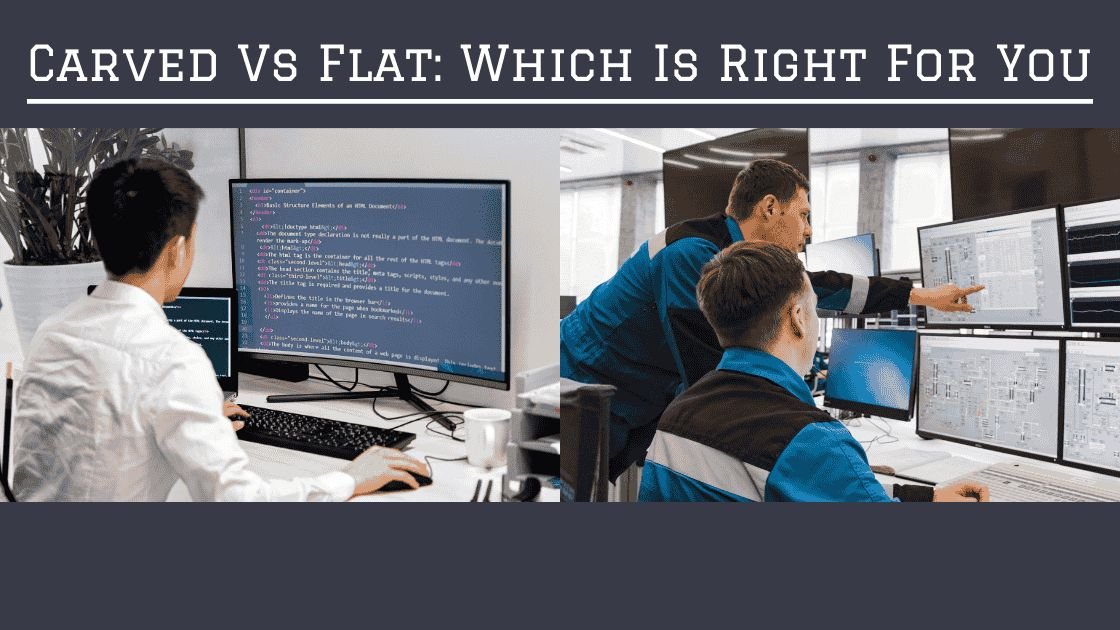The Pros and Cons of Curved Monitors
More and more people are opting for curved monitors for their working and recreational configurations. Different people are drawn to the curved monitors because of its aesthetic look and thrilling digital experience, attracted by various roles such as gaming fanatics as well as skilled video editors and graphics designers. Nonetheless, are curved monitors better than flat Monitors? Read on to understand better about the pros and cons of these devices so that you can make an informed decision before purchase.

What Are Curved Monitors?
Curved computer screens are monitors whose screens have a gentle inward curve to provide an immersive and natural viewing experience. In contrast to flat computer screens that have completely straight edges, they are designed to snake around the user’s field of vision slightly. Due to this twisting around, these devices offer a more engaging visual experience as they match up more closely with how our eyes really see things from side to side. Below are the key things you should know on curved monitors:
Pros of Curved Monitors

1. Enhanced Immersion and Field of View
Curved monitors provide an immersive viewing experience. Gamers and multimedia users are the main beneficiaries of this feature. The peripheral vision is synchronized by curved monitors; thereby creating a broader view that can make playing games and watching movies more attractive and realistic.
2. Reduced Eye Strain
Curved screens are made curved in the same way that a human eye is naturally curved, in order to provide a more comfortable way of viewing things. For this reason. Viewing on a curved display reduces unnecessary strain on the eyes when looking at the center or edges of the surface, which can result in reducing the level of fatigue that can result from using a standard screen monitor. Especially for people who work long hours on their PC.
3. Improved Depth Perception
Curved monitors provide users with better sense of reality through depth perception. The screen’s curvature gives it an illusion so it seems three-dimensional and further enriches its depth specific details, especially on images alongside graphics. For those who are involved in disciplines related to creation such as video editing,3D modeling or graphic designs; this offers an additional clarity aspect to their work because they will be able to see more details than before.
4. Reduced Glare and Reflection
Curved monitors help minimize glare from ambient light sources because they tend to minimize the angles at which light strikes the screen. Some setups may exhibit these features more strongly than others; nevertheless, curved monitors can also enhance visibility at home or work where there are difficulties with overhead light, such as abundant daylight entering through windows or presence of shiny objects.
5. Ideal for Multi-Monitor Setups
When you’re setting up multiple monitors side by side, opting for curved ones might be a smart move since they allow you to have a continuous display without any wide gaps between them caused by bezels. The segment that often finds this layout preferable is made up of gaming enthusiasts, stockbrokers, and data professionals who must see all information on their screens promptly and continuously. Several curving screens envelop the computer user in all directions with their image, creating a highly attractive viewing experience.
6. Enhanced Contrast and Color Uniformity
Across the eyes of the screen, a curved monitor usually grants improved color uniformity and contrast. The light is generally spread more evenly due to the curve. This can help in minimizing color shifts as well as contrasting loss at times found at the edges of bigger flat screens. The target population of this specific attribute is graphic designer and photographers seeking uniformity in terms of color accuracy while working across their space.
7. Better Immersion in Large Sizes
Curved screens are truly essential in a bigger size (especially 34 inches (86.36 cm) and above) since it helps make the edges of the screen appear closer to the viewer’s eyes by curving it. This especially helps in the case of widescreen and ultrawide monitors. Where a uniform distance between the eyes and all parts of the screen is maintained so as not to distort or stretch anything at the corners when viewing everything on the screen. Therefore, what you get is an entirely immersive and seamless viewing experience that flat monitors at larger sizes usually fail to deliver.
8. Improved Ergonomics for Peripheral Vision
Curved monitors minimize the necessity of frequent head movements through matching the natural curvature of human peripheral vision. This ergonomic benefit has particular importance for those professions involving either use of multiple windows simultaneously or need to constantly move from one part of the screen to another. Users can avoid neck strain for a long period by having good posture, since they do not need to turn their heads while working on such monitors.
9. Superior Gaming Performance on Ultrawide Monitors
For gamers, an ultrawide curved monitor offers a wider view. It increases awareness of situations when playing games, especially in open-world or first-person shooter games. The wider field of view helps gamers compete better because they can look at things from a distance without using extra side monitors. There are lots of such people who enjoy curved ultrawide screen more than they would like any flat screen while playing computer games.
10. Enhanced Productivity in Split-Screen Tasks
Curved monitors are good for productivity tasks that need to have many windows open side by side at the same time. Their design makes it easier to split the screen into sectors or different chambers, which enables you to run several applications concurrently without using more than one display screen. They are especially valuable when it comes to programming, analyzing data or designing as workers in these fields need to conduct more than one activity.
Cons of Curved Monitors

1. Higher Price Point
In general, curved monitors cost more money than flat-screens do. The high price of these devices is due to their complex mechanisms and high-quality screens. However, many people may not find it necessary to pay more for such kind of monitors, if only because other types give them almost the same great viewing.
2. Limited Viewing Angles
The main drawback to a curved monitor are its limited viewing angles, this is because unlike flat screens, which can be viewed at almost any angle; curved monitors are designed specifically for head-on viewing only – making them unsuitable for communal workspaces or locations where many people have to look at a screen at the same time since only one person can get an optimum viewing experience.
3. Bulkier Design
Compared to flat monitors, curved monitors are usually more bulky and require bigger desk spaces. Their being curved means that the holder and design requirement for them may take a little extra space in terms of proper positioning- this can be disadvantageous, especially if one is using a relatively small working area. Furthermore, because of their heavy weight and peculiar shape; mounting such screens onto either an arm or wall may prove to be quite hard.
4. Not Ideal for All Types of Work
For jobs that need straight-line precision, curved displays are unsuitable, for instance working in the CAD sector, architectural planning, or types of spreadsheet analysis which are specific. A little deformation in terms of line perception can be caused by the curve, and this may irritate those that work with their eyes in places where there are strict demands on visible accuracy while doing this professionally. On the other hand, flat panels give less biased outputs, hence being versatile enough for multiple uses.
5. Compatibility Issues with Content
Some older games, software, or media content might not utilize a curved screen in the best possible way, resulting in image stretching or distortion. There are instances when it seems as if part of the data on one’s monitor is different from one that has a straight line display. Nevertheless; if there is anything that doesn’t fit within these criteria, then such inconvenience is usually minor and difficult to notice every time unless we compare our usual displays with those designed specifically for such purposes.
Curved Monitors vs. Flat Monitors: Which Is Right for You?

If you are choosing between a curved and flat monitor, think of the main area where you will be using it:
- For gaming and entertainment: In gaming and multimedia experiences, curved monitors are better suited to first-person shooters, racing games, and films because they provide an immersive view.
- For professional use: In situations that require a lot of data analysis tasks, flat monitors could provide better practical and cost-effective solutions with no limited viewing angle problems.
- For creative work: In creative fields; curve monitors will help to increase depth perception, thus making it easier to see designs more easily, though this might require some fine-tuning for color accuracy and visibility.
Summary: Are Curved Monitors A Good Choice?
The decision on whether to go for a curved or flat monitor depends on different factors including personal preferences, financial capability and type of activities one is involved in at work. As such, curved monitors are just perfect for gamers, video editors or streamers in need of that immersive feel while using them. However, this kind of screen may not provide the best solution for someone with limited resources looking forward to using his/her computer both at home and office.
Despite their notable drawbacks, curved monitors present irresistible sets of advantages. It is therefore important to understand these tradeoffs prior to making a purchase. Your setup might just require a curved monitor, yet flat ones are also okay depending on what exactly you require.
